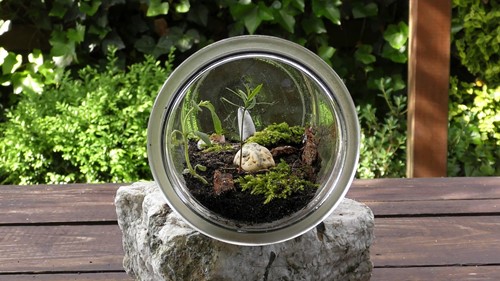
Image by AndyFaeth from Pixabay
If you're searching for ways to introduce a little extra green into your home and at the same time learn a satisfying hobby consider building a terrarium.
Putting together a terrarium is a learning experience for grown-ups and can draw in kids as well. Not only do you see your handiwork grow and thrive, but you’ll observe a real-life example of a working ecosystem. A terrarium, if it’s a closed one, recycles its oxygen, carbon dioxide and water.
What Is a Terrarium?
In simplest terms, it’s a glass container for growing plants. There’s a variation called a vivarium, a similar construction with small animals, but plants are a great starting point.
Terrariums (either “terrariums” or “terraria” is an acceptable plural) can be either open or closed. Open terrariums are better for plants that can’t tolerate moisture buildup.
How To Build a Terrarium
First, find a glass container. For a closed terrarium, any glass container with a removable lid will work. You can order one or find one around the house. It could be a rectangular glass box with a top or a rounded jar with a stopper. A Mason jar, either upright or on its side. A covered fishbowl. A cookie or candy jar. You can also use plastic if it’s clear and resists fogging.
Lay down a base. Use rocks, plain or colored gravel, seaglass or other decoratives. This is your drainage layer. It should be about an inch deep, but that can vary depending on the size and shape of your container. The finished product will need enough “headroom” for your little garden. The base layer doesn’t have to be flat; you may shape it to create peaks and valleys.
Some sources recommend a ½ inch layer of charcoal next as a water filtrate.
Create a barrier for your soil with sphagnum or sheet moss. Soak it briefly, squeeze out the water and mold it into place.
Add about two inches of soil. Common potting soil is good for most plants. If your gravel layer is flat your can shape this to make miniature hills and valleys.
Now you’re ready to plant. Use slow growing vegetation and dwarfs. Peperomia, ferns (maidenhead, button ferns), pilea and dwarf palms are good choices, as well as miniature coleus, violets, begonias. There are suitable lichens and mosses.
As for maintenance, there’s not much. After an initial watering, you have only to keep it moist. For a closed system, which recycles water, a light mist every few weeks is adequate. Once a week, briefly remove the cover to rebalance the air. Trim plants to keep them small. Terrariums do best in indirect sunlight. The glass can magnify direct rays.
About the Author

Robin Anderson Real Estate
“My Passion is people and relationships and I promise to provide my clients with exceptional service tailored to their individual needs.” -Robin Anderson
Georgia native, Robin Anderson brings her passion for people and her love of homes to work for her clients. She and her husband, Andy, have been married for over 30 years and have two adult children, Ellen and Drew. They currently live in Fulton County, but Robin has lived and invested in properties throughout metro Atlanta as well as helped clients buy and sell. She has been integral to many real estate endeavors including designing and building several custom homes, remodeling homes, subdividing land, managing rental properties, and buying and selling properties. She spent her first 3 years in real estate working with a new home builder, and she has spent the last 6 years working with buyers and sellers in her own community. Robin is highly motivated but sensitive to the fact that buying and selling homes can be an emotional experience, so she makes it a priority to keep clients closely informed throughout the process and strives to produce quick results. She appreciates the opportunity to help her clients navigate the real estate process, and she aspires to deliver quality customer service that is both informative and positive. She is driven to provide outstanding service for her clients and she is focused on building successful and lasting relationships with her clients. This personalized service earns her enthusiastic referrals from clients she is pleased to call friends.Edit
